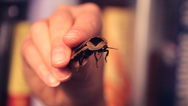The Hummingbird Drone
- By Anna Rothschild
- Posted 10.31.13
- NOVA
The military wanted a new type of drone—one that was small, low-flying, and unlike any other machine on the market. So Matt Keennon and his team at AeroVironment built the Nano Hummingbird, a drone that beats its wing like a bird.
Transcript
The Hummingbird Drone
Posted: October 31, 2013
NARRATOR: Unmanned aerial vehicles, or as most of us know them, “drones,” can perform detailed surveillance from thousands of feet in the air. But the military decided it wanted to build a smaller drone that could operate closer to the ground. And while they were at it, they wanted to test the limits of aerial engineering—creating something that might work even better than a typical plane or helicopter-shaped vehicle.
The challenge fell to AeroVironment, a manufacturer of unmanned aircraft systems, which set out to build a new type of drone. “Making Stuff” host David Pogue met with engineer Matt Keennon, who drew inspiration from hummingbirds.
DAVID POGUE: So of all the flying creatures in nature, why would you choose the hummingbird?
MATT KEENNON: Well, the hummingbird is an amazing flyer. They’re very quiet and they’re extremely maneuverable. They’re capable of flying forward, backward, sideways, left, right, rotating. They can do all those motions at the same time, and they only have two moving parts—just the two wings.
NARRATOR: Keennon and his team decided to build an ornithopter, a machine that flies by beating its wings like a bird. Plans for simple, wooden ornithopters can be found all over the web.
DAVID POGUE: Holy cow!
MATT KEENNON: There are versions of this that can fly up to a half an hour.
DAVID POGUE: Come on.
MATT KEENNON: Just silently flapping their wings. The light shimmering off the Mylar covering. But look at the mechanism at the back. It’s amazing. Balsa wood, push rods, and little tiny pins for hinges. And all driven by a rubber band that’s like holding up your socks.
NARRATOR: But Keennon needed to make something a little more complicated. While this ornithopter can flap its wings, it can’t do what hummingbirds can do with ease: hover.
A hummingbird has to flap its wing forward at an angle, flipping the angle to keep generating upward thrust for a hover. All of that at up to 80 times a second, according to experts.
But it’s not that easy for an aircraft. Building wings that could beat anywhere near that fast while staying aloft took a few years of bioinspired failures along with over three hundred different wing designs. But the work paid off, and Keennon and his team finally developed the Nano Hummingbird.
MATT KEENNON: All right, so let’s do a little test flight here. Taking off from the ground.
DAVID POGUE: Oh, come on. That’s amazing. How many flaps a second is that?
MATT KEENNON: It’s about 30 flaps per second.
DAVID POGUE: How much can you maneuver it? Here, can you…
MATT KEENNON: (laughs) We can try that. Let’s see.
DAVID POGUE: Unbelievable!
NARRATOR: The Nano Hummingbird weighs only 19 grams—that’s less than a double A battery. And it’s equipped with a video camera, turning this little bird into a secret agent. But it’s probably not going on a top-secret mission anytime soon.
MATT KEENNON: It can only fly in very fair weather, very short range, very short endurance. It’s just a demonstrator of the basic technology.
NARRATOR: But Keennon says this is really just the beginning.
MATT KEENNON: So it’s like the Wright Brothers, just making that little hop. The very first step.
Credits
PRODUCTION CREDITS
- Camera
- Jason Longo
- Additional Camera and Hummingbird Slow Mo by
- Bruce Johnson
- Sound by
- Michael Krikorian
- Narrated by
- Anna Rothschild
- Original Footage
- © WGBH Educational Foundation 2013
MEDIA CREDITS
- (A Hummingbird Hovers in Front of a Bird Feeder)
- Getty Images/Discovery FootageSource
IMAGE
- (main image: Nano Hummingbird)
- © WGBH Educational Foundation 2013
Related Links
-

Making More Stuff
Host David Pogue hits the road to explore the frontiers of invention and innovation.
-

RoboBees to the Rescue
Could tiny drones be the pollinators of the future?
-

Evolution of Bioinspired Robots
To build a better robot, engineers are turning to an experienced problem solver—nature.
-

Cockroach Cyborgs
Scientists are turning cockroaches into robots—and you can, too.

